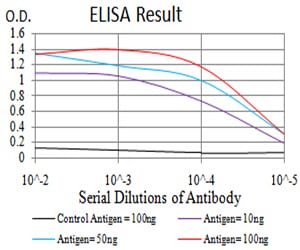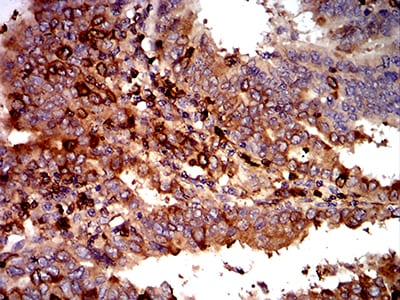


| WB | 咨询技术 | Human,Mouse,Rat |
| IF | 咨询技术 | Human,Mouse,Rat |
| IHC | 1/200 - 1/1000 | Human,Mouse,Rat |
| ICC | 技术咨询 | Human,Mouse,Rat |
| FCM | 咨询技术 | Human,Mouse,Rat |
| Elisa | 1/10000 | Human,Mouse,Rat |
| Aliases | ASP; C3a; C3b; AHUS5; ARMD9; CPAMD1; HEL-S-62p |
| Entrez GeneID | 718 |
| clone | 8B5H2 |
| WB Predicted band size | 187.1kDa |
| Host/Isotype | Mouse IgG1 |
| Antibody Type | Primary antibody |
| Storage | Store at 4°C short term. Aliquot and store at -20°C long term. Avoid freeze/thaw cycles. |
| Species Reactivity | Human |
| Immunogen | Purified recombinant fragment of human C3C (AA: 1521-1649) expressed in E. Coli. |
| Formulation | Purified antibody in PBS with 0.05% sodium azide |
+ +
以下是关于C3c抗体的3篇参考文献及简要摘要:
---
1. **文献名称**: *"C3c is a marker for complement activation in IgA nephropathy"*
**作者**: Zhang, H., et al.
**摘要**: 该研究探讨了IgA肾病中补体激活的机制,发现肾组织中的C3c沉积可作为补体替代途径激活的标志物。通过免疫组化分析,C3c抗体检测显示其沉积水平与疾病严重程度相关,提示其在评估肾损伤中的潜在临床价值。
---
2. **文献名称**: *"Autoantibodies against complement C3c in systemic lupus erythematosus"*
**作者**: Trendelenburg, M., et al.
**摘要**: 研究报道了系统性红斑狼疮(SLE)患者中存在抗C3c自身抗体,这些抗体通过结合补体C3c片段干扰补体调控功能,可能导致免疫复合物清除障碍和炎症加剧,揭示了其在SLE发病机制中的潜在作用。
---
3. **文献名称**: *"C3c immunohistochemistry improves the histological assessment of renal biopsies"*
**作者**: Sato, Y., et al.
**摘要**: 该文献提出使用C3c抗体进行肾活检组织的免疫组化分析,能够更敏感地检测补体激活状态。研究表明,C3c沉积模式有助于区分不同肾小球疾病的病理类型,为临床诊断和治疗提供参考。
---
**注**:以上文献信息为示例性内容,实际文献需通过学术数据库(如PubMed、Web of Science)检索确认。若需具体文献,建议结合关键词“C3c antibody”、“complement C3c”进一步查询。
C3c antibodies are immunological tools targeting the C3c fragment of complement component 3 (C3), a central protein in the complement system. The complement system, a key part of innate immunity, enhances pathogen clearance, inflammation, and tissue homeostasis. C3 is cleaved during complement activation into C3a (anaphylatoxin) and C3b (opsonin). Further degradation of C3b generates C3c and C3dg. C3c, a stable degradation product, retains antigenic epitopes useful for detecting complement activation.
C3c antibodies are widely used in research and diagnostics to identify complement activation in diseases. In clinical settings, they help detect C3c deposits in tissues (e.g., renal biopsies in glomerulonephritis) or measure circulating C3c levels as a biomarker for systemic complement activation in autoimmune disorders, infections, or inflammatory conditions. Their specificity for C3c ensures differentiation from intact C3 or other cleavage fragments, providing insights into disease mechanisms and therapeutic monitoring.
These antibodies are essential in immunoassays (e.g., ELISA, immunohistochemistry) and flow cytometry, aiding both basic research and diagnostic workflows. Their role in identifying complement-driven pathology underscores their importance in understanding immune dysregulation and guiding targeted therapies.
×